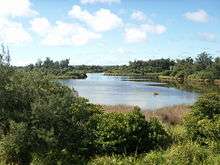Ikejime
Ikejime (活け締め) or Ikijime (活き締め) is a method of paralyzing fish to maintain the quality of its meat. The technique originated in Japan, but is now in widespread use. It involves the insertion of a spike quickly and directly into the hind brain, usually located slightly behind and above the eye, thereby causing immediate brain death. When spiked correctly, the fish fins flare and the fish relaxes, immediately ceasing all motion. Destroying the brain and the spinal cord of the fish will prevent reflex action from happening; such muscle movements would otherwise consume Adenosine triphosphate (ATP) in the muscle, and as a result produce lactic acid, making the fish sour. Furthermore, the blood contained in the fish flesh retracts to the gut cavity, which produces a better coloured and flavoured fillet. This method is considered to be the fastest and most humane method of killing fish.
It is very similar to the technique used on frogs in laboratories called spiking or pithing.
Another technique in APEC Air shipment of live and fresh fish and seafood guidelines is described as follows: "A cut is made toward the front of the flatfish severing the major artery and the spinal cord. Placement of the cut is made to preserve the greatest amount of flatfish flesh. This paralyzes the flatfish. A second cut is made in the tail to hasten the removal of blood. Flatfish are then chilled slowly to maintain circulation and facilitate the bleeding process. After the flatfish have been bled, they are transferred to a salt/ice water slurry and chilled to 12°C."
Ike
Ike may refer to:
Weather
- Typhoon Ike, in the 1981 Pacific typhoon season, a category 1 typhoon that formed in the South China Sea
- Typhoon Ike (1984), the deadliest typhoon of the 1984 Pacific typhoon season
- Hurricane Ike (2008), the third-costliest hurricane to ever make landfall in the United States
People
Technology
Other uses

Ōike
Ōike (大池) is a karst pond in Minamidaito island, Okinawa Prefecture, Japan. Ōike is the largest pond containing both freshwater and seawater. It covers 0.31 square kilometres (0.12 sq mi), the circumference is 5.50 kilometres (3.42 mi), and it is 1.3 metres (4 ft 3 in) at its deepest point. Fresh water is mixed with seawater beneath.
Geology
The island is composed of elevated limestone from its atoll. Rainwater has dissolved the limestone leading to a depression in the ground (sinkhole). This has filled with water to become a pond.
Natural history
On the north of the pond extends an area of wetland with large communities of Bruguera gymnorrhiza, a mangrove plant, which was designated as a Natural monument since it is unique in freshwater on March 18, 1975. Other plants include Scirpus tabemaemontani C. C. Gemlin, Panicum repens L. Najas marina and Vallisneria natans.
Common carp and Carassius auratus langsdorfii were introduced in 1910 and tilapia in 1955. Birds include mallard, Pacific reef heron, common moorhen and cattle egret.
Ike Lozada
Enrique "Big Ike" Lozada, also known as Kuya Ike, or Iking (August 13, 1940 – March 8, 1995) was a Filipino comedian, actor and TV host.
Early life
Lozada was born on August 13, 1940 in Iloilo City. He started acting at the age of 11 on the movie Mga Bituin ng Kinabukasan with the younger Susan Roces.
Death
He died on March 8, 1995 in Manila of a heart attack. He was 54. His remains were laid to rest at the Manila Memorial Park in Parañaque City.
Filmography
Movies
Podcasts:

